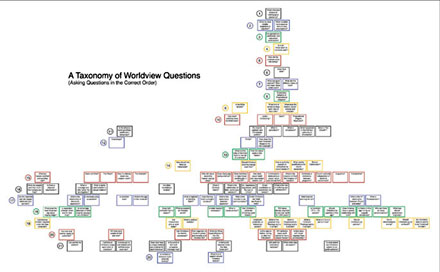Foundations
for Christianity:
202
Foundations of Our Theology
and Hermeneutics
Taxonomy
of Worldview Questions

(Click
on the image above to enlarge. Opens
in new window.)
Perhaps whether
we like it or not and whether we know it or not, ideas and
beliefs are arranged in an order of dependence so that certain
beliefs form the conceptual basis from which and upon which
all of our other beliefs depend. Understanding and decisions
on more fundamental or major questions affect positions on
subsequent major and minor issues. In other words, for each
one of us there are certain values, beliefs, or decisions
that take priority over all others and by which all others
are subsequently determined.
These more "fundamental" or "foundational" beliefs that, in
turn, dictate or influence the rest of an individual's worldview
are often referred to as "pre-suppositions." When individuals
engage in discussions about worldviews, often the debate is
spent focussing on "later" concepts without ever addressing
or identifying the underlying pre-suppositions that are
determining each individual's position on the topic at hand.
This can happen both when two Christians discuss doctrine
or when a Christian and non-Christian discuss their differing
worldviews. And simply having a pre-supposition isn't bad
on its own. Its whether or not a person understands their
own pre-suppositions, builds them logically one from the next,
and identifies them in their discussions with others, that
determines how skilled they are as a rational thinker and
even how valid their beliefs are. Persons whose beliefs are
arbitrarily constructed, without their own understanding of
where they came from or why they hold those views cannot be
deemed "wise" concerning such matters, no matter what their
worldview, Christian or not.
When the most fundamental disagreement is not identified and
only "later" or "secondary" questions remain the focus, then
conversations cannot be productive, no matter how much evidence
is presented and no matter how persuasive the arguments are.
When each side's view is ultimately governed by an earlier
pre-supposition that is never itself discussed, neither party
will ever be discussing their real source of disagreement
- their differing pre-suppositions. And since their real disagreement
is not being analyzed and no evidence or argument is being
brought to bear on it, there can be no hope of bridging
the gap and arriving at rational persuasion, and ultimately,
agreement. Conceptually, this approach is like trying to cure
disease, without ever identifying the root cause, but instead
only looking at the symptoms. Doctors can treat symptoms all
day, but unless they are able to identify and treat the underlying
cause, problems will simply remain unabated.
This chart as well as the "Taxonomy
of Systematic Theology Chart" are designed
to show the relative heirarchy and flow between individual
concepts within theological thought and history. In the chart
below, questions are arranged on 22 levels, with the more
fundamental questions depicted at the top with the lowest
numbers. The goal of the chart is to facilitate making discussions
about worldviews and Christian doctrine more productive by
enabling parties engaged in a discussion, to actually identify
and start with their most foundational disagreement - to build
agreement from where the real source of disagreement lies.


























